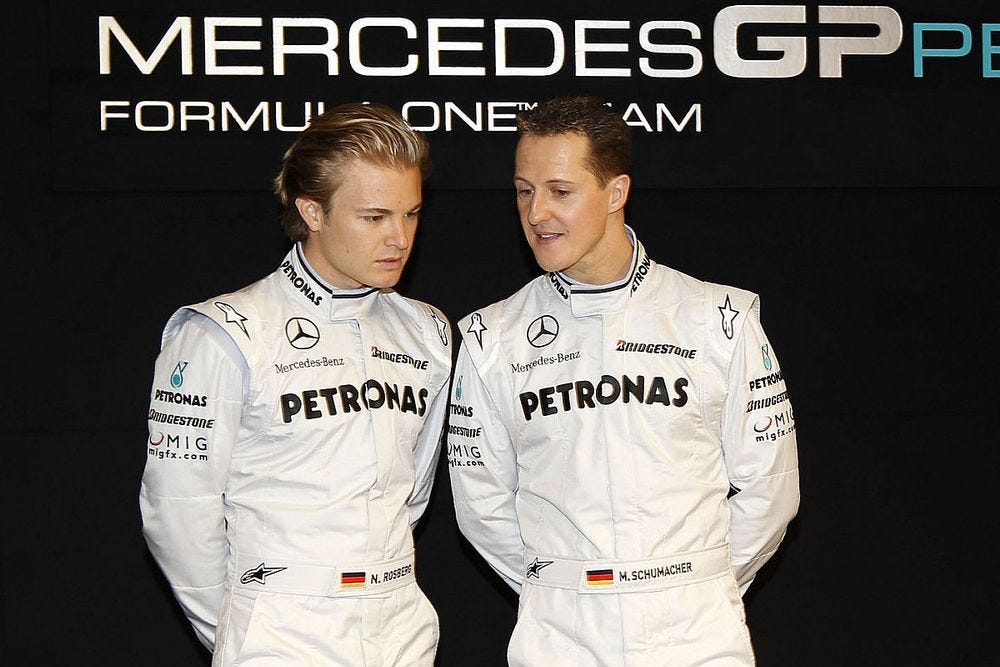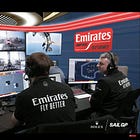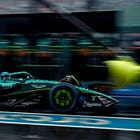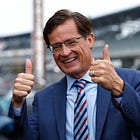Why Michael Schumacher Won Before the Race Even Started
How Formula 1’s most systematic driver turned preparation, precision, and psychology into a winning machine
When I sat down to write this dispatch, I happened to be seated next to my copy of Mamba Mentality, and thought to myself, “How can I make this about motorsports?”
I gave it about .174 seconds of thought when I realized that Kobe was just Michael Schumacher in a different arena.
So, I decided to pair my decade of experience working with some of the world's largest brands and C-suite executives, along with my love of Kobe and Schumi, into this piece. I hope you enjoy it.
One might reflect on Michael Schumacher’s domination of Formula 1 and say it’s because he was the fastest driver on the grid.
But Schumacher’s real advantage wasn’t just his lightning-quick Ferraris.
It was obsessive systematization. While rivals chased tenths with talent, he built compound edges that made victory inevitable before the lights went out. He treated performance as an operating system: design the architecture, instrument the inputs, run tighter feedback loops than anyone else, and compound.
This is the same truth Kobe Bryant called Mamba Mentality: relentless improvement through preparation that others won’t match. Not talent. Not theatrics. Systems.
The Schumacher Operating System
Schumi won because he engineered winning into every layer of his preparation. His approach was an integrated architecture that connected data, fitness, feedback, strategy, and culture into a single machine. Every component reinforced the others, creating a loop where advantages compounded over time.
What follows isn’t folklore or myth.
It’s the blueprint of how Schumacher built an operating system for performance that turned every race into a controlled experiment and every season into a masterclass in inevitability.
Data architecture
Schumacher didn’t treat telemetry as a post-session debrief; he treated it like oxygen. He wanted comprehensive data, every run, every lap, every micro-sector. Lap time was the headline; tire degradation patterns, brake temperature evolution, and suspension load traces were the story.
He obsessed over the why and the how, not just the what. And he built shared mental models with his engineers so decisions could be made faster, with more context, under pressure.
Physical preparation
Before fitness became fashionable in F1, Schumacher reframed the job: be fitter than the car demands.
He built his program around endurance, strength, neck conditioning, and recovery in an era of refueling sprints where every lap mimicked qualifying. Teammates called it “a pain in the ass” because it forced the entire grid to raise their standards.
That was the point.
Superior conditioning wasn’t vanity; it was repeatability, reducing variance at the edge of fatigue. He finished seasons head and shoulders above the field in testing mileage even after his third, fourth, and fifth titles because the system demanded reps.
Feedback loop
All drivers debrief.
Schumacher ran debriefs like design sprints. Longer, deeper, relentlessly causal. Not “the rear stepped out,” but “the rear stepped out in phase with brake temps rising 20°C over two laps with a growing crosswind at Turn 11; adjust rear rebound two clicks and bias plus 0.2.”
He didn’t just catalog symptoms; he institutionalized fixes. The loop was simple: instrument, interpret, intervene, iterate. Then repeat until the failure mode disappears or the strength becomes a weapon.
Scenario planning
Champions don’t rely on luck; they minimize its impact.
Schumacher’s pre-race preparation covered contingencies for various weather conditions, safety cars, tire wear, fuel offsets, undercutting, overcutting, and competitor tendencies.
The result was that he could execute improbable strategies, such as turning three-stop sprints into race winners, because his team had modeled the edges, and he could deliver qualifying laps on demand, lap after lap, even under fatigue.
Psychology
Nico Rosberg called him a psychological warrior.
This wasn’t random mind games. It was culture by design.
He projected inevitability: present, prepared, physically imposing, totally comfortable at the ragged edge.
He remembered names, birthdays, and the details that create tribal loyalty. He moved with his core engineers from Benetton to Ferrari, institutionalizing trust and fostering a culture of speed. The message was consistent: this is how champions operate here.
Mamba Methodology
Kobe Bryant wasn’t the most explosive athlete in NBA history.
He was the most systematic.
He built shot mechanics into muscle memory with 800 makes before sunrise. He broke down film into footwork micro-patterns, cadence changes, and defender hips. He stress-tested counters for every coverage. He treated big moments as outputs of thousands of controlled inputs.
That’s Schumacher: same mentality, different arena.
Obsessive preparation: early mornings, extra reps, no off switch
Micro-skill compounding: angles, footwork, timing vs. lines, braking, throttle
Psychological pressure as a tool: set a standard, force the room to rise
Systems over moments: the shot at the buzzer and the lap at the limit are byproducts
The Choice
Most leaders chase moments: the launch, the viral spike, the hero close. Champions build operating systems. Schumacher and Kobe understood the same thing: excellence isn’t an event; it’s a methodology.
While others tried to go faster, Schumacher prepared smarter. While others celebrated games, Kobe optimized seasons. While rivals trusted talent, Kobe and Schumi built processes that delivered under pressure.
You have the same choice. Compete on talent—or compete on systems.
If you want the Mamba x Schumacher treatment, start here:
This week: pick one function and write the telemetry you wish you had. Instrument it.
This month: run a pre-mortem on your next launch. Build two contingencies and rehearse them.
This quarter: ship one playbook that replaces heroics with repeatability.
Win the inputs. The outputs will follow.
What’s the one system in your business that needs the Mamba x Schumacher upgrade?
You are receiving this email because you subscribed to Business of Speed, the newsletter for those wanting to stay ahead on what’s happening behind the scenes. I’m Vincenzo Landino, a business, tech, and F1 commentator. I’ve spent the last ten years at the intersection of content, partnerships, and the business of motorsport. This newsletter is where I break down what’s working, what’s shifting, and what’s next without the PR gloss. Thank you for being here.







